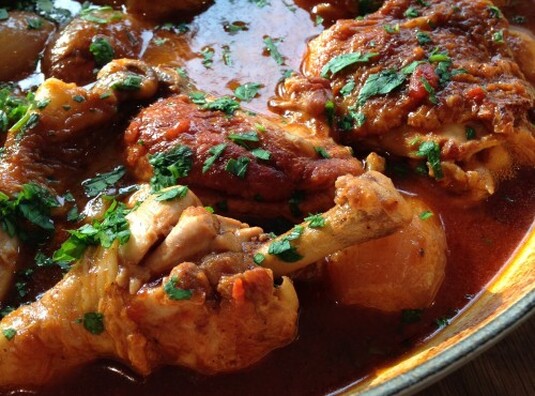La Plat Principal (Main Course)
The region of Beaujolais was first cultivated by the Romans who planted vineyards along its trading route up the Saône valley. The most noticeable Roman vineyard was Brulliacus located on the hillside of Mont Brouilly. From the 7th century through the Middle Ages, most of the viticulture and winemaking was done by the Benedictine monks. In the 10th century, the region got its name from the town of Beaujeu, Rhône and was ruled by the Lords of Beaujeu till the 15th century when it was ceded to the Duchy of Burgundy. The wines from Beaujolais were mostly confined to the markets along the Saône and Rhône, particularly in the town of Lyon. The expansion of the French railroad system in the 19th century opened up the lucrative Paris market. The first mention of Beaujolais wines in English followed soon after when Cyrus Redding described the wines of Moulin-à-Vent and Saint-Amour as being low priced and best consumed ‘young’.
This iconic chicken dish is the perfect main event – for lunch, dinner or as part of a ‘true’ French buffet. The light fruitiness of Beaujolais is clearly echoed in the sauce for this chicken. If Beaujolais is unavailable, a quality Pinot Noir could be substituted, but if you use red wine with a different character, you will have a different dish.
The region of Beaujolais was first cultivated by the Romans who planted vineyards along its trading route up the Saône valley. The most noticeable Roman vineyard was Brulliacus located on the hillside of Mont Brouilly. From the 7th century through the Middle Ages, most of the viticulture and winemaking was done by the Benedictine monks. In the 10th century, the region got its name from the town of Beaujeu, Rhône and was ruled by the Lords of Beaujeu till the 15th century when it was ceded to the Duchy of Burgundy. The wines from Beaujolais were mostly confined to the markets along the Saône and Rhône, particularly in the town of Lyon. The expansion of the French railroad system in the 19th century opened up the lucrative Paris market. The first mention of Beaujolais wines in English followed soon after when Cyrus Redding described the wines of Moulin-à-Vent and Saint-Amour as being low priced and best consumed ‘young’.
This iconic chicken dish is the perfect main event – for lunch, dinner or as part of a ‘true’ French buffet. The light fruitiness of Beaujolais is clearly echoed in the sauce for this chicken. If Beaujolais is unavailable, a quality Pinot Noir could be substituted, but if you use red wine with a different character, you will have a different dish.
Poulet au Beaujolais– Chicken with Beaujolais wine and onions
Serves 6. Start at least 12 hours prior to cooking. The chicken can be prepared up to three days ahead and kept in the sauce in the refrigerator, or it can be frozen.
|
INGREDIENTS:
For the marinade
|
METHOD:
Kneaded butter
Recipe from La France Gastronomique by Anne Willan.
- For the marinade: in a saucepan, combine the wine, onion, carrot, celery, bouquet garni, garlic and peppercorns, bring to the boil and simmer for 5 minutes; let cool completely. Pour the marinade over the chicken, top with the oil, cover and leave at room temperature for 12 hours or in the refrigerator for 24 hours, turning the pieces occasionally.
- To cook: Drain the chicken pieces and pat dry with paper towels. Strain and reserve the marinade and vegetables. In a sauté pan or shallow casserole, heat half the oil and half the butter. Add the chicken pieces, skin side down, and sauté over medium heat until brown, allowing at least 5 minutes. Turn, brown the other side, and remove them from the pan.
- Add the reserved vegetables and bouquet garni from the marinade and cook until slightly soft, stirring occasionally for 5-7 minutes. Stir in the marinade, bring to the boil and simmer for 5 minutes. Add the stock, garlic, shallots, salt and pepper and replace the pieces of chicken. Cover and simmer on top of the stove or in a moderate oven (350F/175C) until the chicken is tender, 30-45 minutes. If the pan gets dry during cooking, add more stock.
- Heat the remaining oil and butter in a frying pan, add the baby onions, salt and pepper, and sauté until the onions are tender, 15-20 minutes. Shake the pan occasionally so the onions brown evenly.
- Remove the chicken pieces from the liquid and strain it. Discard the vegetables and the bouquet garni. Taste and, if necessary, boil the liquid until concentrated. Whisk in enough kneaded butter so that the sauce lightly coats a spoon. Taste it for seasoning, stir in the sautéed onions and replace the chicken.
- To Finish: if necessary, reheat the chicken and sauce on the top of the stove. For the croutes. Serve the chicken in the casserole or on individual plates, sprinkled with parsley and croutes on the side.
Kneaded butter
- This is a paste made with butter and flour that is used to thicken a liquid at the end of cooking. It makes a richer, more traditional sauce than a starch thickener such as arrowroot. To make, mash equal amounts of butter and flour together with your fingers or a fork until smooth. Add the kneaded butter gradually to boiling liquid, whisking constantly so that the butter melts and distributes the flour, thus thickening the sauce evenly. Continue boiling, adding the butter piece by piece until the sauce has thickened to the desired consistency. Kneaded butter can be made in large quantities and kept for several weeks in the refrigerator.
- Croutes are fried or toasted slices of bread used to add texture or to garnish dishes. If using French bread, cut the loaf into thin diagonal slices; if using sliced white bread, cut the bread into squares, triangles, rounds or hearts, discarding the crusts. They are not the same as Croutons, which is bread cut into cubes and fried.
- Fried Croutes: heat enough oil or butter, or a combination of the two, in a frying pan to coat the bottom generously. Add the slices of bread in a single layer, brown them on both sides over a brisk heat and drain them on paper towels.
- Toasted Croutes: bake the sliced bread in an oven heated to 350F/174C for 10-15 minutes, turning the croutes halfway through so they brown evenly on both sides. For a lightly fired effect, brush the sliced bread on both sides with melted butter before baking.
Recipe from La France Gastronomique by Anne Willan.

